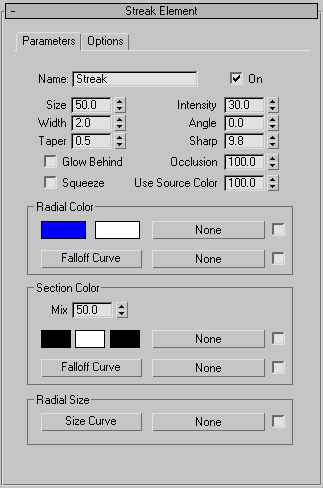A streak is a wide band that runs through the center of the source object. In real camera work, it is produced when using anamorphic lenses to film a scene.

Adding a streak to the light
Streak Element rollout, Parameters panel

Mixes the source color of the light or object you are applying the effect to and the color or mapping set in the Radial Color or Circular Color parameters. A value of 0 uses only the values set in the Radial Color and Circular Color parameters while a value of 100 uses only the light or objects source color. Any value between 0 and 100 will render a mix between the source color and the effect’s color parameters.
Displays the Radial Falloff dialog in which you can set weights for the colors used in Radial Color. By manipulating the Falloff Curve you can make the effect use more of one color or map than the other. You can also use a map to determine the falloff when a light is used as a Lens Effects source.
Section Color determines the color of the effect by using three different color swatches that are matched to the three sections of the effect. A map can also be used to determine section color.
Displays the Circular Falloff dialog in which you can set weights for the colors used in Section Color. By manipulating the Falloff Curve you can make the effect use more of one color or map than another. You can also use a map to determine the falloff when a light is used as a Lens Effects source.
Determines the radial size around the particular Lens Effect. Clicking the Size Curve button displays the Radial Size dialog. Using the Radial Size dialog you can create points on a line and move those points along a graph to determine where the effect should be placed around the light or object. You can also use a map to determine where the effect should be placed. A check box is used to activate the map.
Applies the Lens Effect to particular objects in your scene that have a corresponding G-Buffer (or Object) ID. The G-Buffer is a geometry buffer and can be defined when you right-click any object and select Properties from the menu. Then, set the Object Channel ID under the G-Buffer ID controls.
Applies the Lens Effect to an object or part of an object with a specific Material ID channel assigned to it. Assign the channel
with the Material Editor  Material ID channel flyout. The effect is applied only to areas of the geometry where that ID channel is present.
Material ID channel flyout. The effect is applied only to areas of the geometry where that ID channel is present.
An unclamped color is brighter than pure white (255,255,255). 3ds Max keeps track of these "hot" areas which tend to show up when your scene contains bright metallic highlights or explosions. This spinner lets you determine the lowest pixel value that the Lens Effect is applied to. Pure white has a pixel value of 1. When this spinner is set to 1, any pixels with a value above 255 will be glowed. You can invert this value by clicking the I button to the right of the spinner.
Applies the Lens Effect to part of an object, based on the angle of the surface normal to the camera. A value of 0 is coplanar, or parallel to the screen. A value of 90 is normal, or perpendicular to the screen. If you set Surf Norm to 45, only surfaces with normal angles greater than 45 degrees will be glowed. You can invert this value by clicking the I button to the right of the spinner.
Filters the Image Sources selections to let you control how the Lens Effect is applied. For example, you can have ten spheres in your scene, each with the same Object ID, but different colors. If you set the Image Source as the Object ID of the spheres, which selects all of the spheres, these will be the only objects in the scene that Lens Effects will apply an effect to.
However, now that Lens Effects knows where the pixels are that effects can be applied, it needs to know which ones to actually apply the effect to. Lens Effects uses the filter controls to find out which source pixels to apply the effect to.
Applies the Lens Effect only to the perimeter of an object based on its alpha channel. Selecting this option applies the effect only on the outside of an object without any spill on the interior. Whereas filtering by Edge produces a spill onto the object, Perimeter Alpha keeps all of the edges clean because it relies on the scene alpha channel to derive its effect.
Filters the source objects by their hue. Select the hue by clicking the color swatch next to the spinner. You can choose hue values from 0 to 255. The spinner beside the Hue color swatch lets you enter a variance level so that the glow can find several different hues in the same range as the chosen color
Additional Effects allows you to apply maps such as Noise to your Lens Effect. You can display the Material/Map browser by clicking the long button next to the Apply check box.
Determines where and how much you would like the additional effects applied. Clicking the Radial Density button displays the Radial Density dialog. Using the Radial Density dialog you can create points on a line and move those points along a graph to determine where the additional effect should be placed around the light. You can also use a map to determine where the additional effect should be placed.